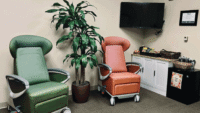Unintentional injuries caused by falls are a serious health problem for adults ages 65 and older. Each year approximately one-third of community-dwelling older adults (those ages 65 and older) fall; roughly 10% of falls lead to nonfatal but serious injuries. What’s more, many older adults experience multiple falls. In the United States, fall-related healthcare expenses are estimated at $27.3 billion. This article addresses falls among older adults living in the community or long-term care facilities.
Why falls occur
Falls result from a complex combination of medical and lifestyle factors, alone or in conjunction with environmental factors. Among older adults in residential-care facilities, acute diseases and drug side effects are important precipitating factors. In these settings, falls should be viewed as a symptom of a disease or a drug side effect unless proven otherwise.
The following aging-related physiologic factors increase the fall risk:
- alterations in mobility, gait, balance, and sensory perceptions
- decreased reflex responses
- cardiovascular and neurologic changes
- changes in drug processing leading to side effects
- acute illnesses
- language and communication disorders.
Multiple diagnoses complicate the clinical picture, potentially causing difficulty in determining the underlying cause of the fall. Here’s a closer look at risk factors and how to manage them.
Medication side effects
Progressive loss of organ-system functional reserve, changes in liver and kidney function, and altered composition of body fat, water, and muscle predispose older adults to adverse drug events. More than 90% of elderly patients in emergency departments already are taking one or more medications; most take an average of four to eight. (See Medications that increase the fall risk.)
Medications that increase the fall riskDrugs that increase the risk of falls, especially in older adults, include nonsteroidal anti-inflammatory drugs (NSAIDs), benzodiazepines, anticholinergics, and opioids. Antidepressants and neuroleptics also are linked to falls. Because these drugs can’t always be avoided, here are suggestions for reducing the risk.
|
Gait and balance disorders
Primary causes of marked gait or balance disorders include muscle weakness, reductions in sensory input, spasticity or rigidity, joint contracture, and central processing dysfunctions. Specific deviations may be compensatory or may relate directly to one or more of these primary causes.
While normal aging can cause gradual and characteristic gait changes, significant problems typically result from specific pathologic processes. To guide treatment selection, clinicians must identify the most probable cause of a gait or balance disturbance. (See Assessing your patient’s functional status.)
Assessing your patient’s functional statusYou can use the tools described below to assess an older adult’s functional status. Tinetti Gait and Balance Assessment toolThis test, which enables clinicians to follow the patient’s progress over time, can be done quickly—either alone or combined with observational gait analysis. The balance portion of the tool evaluates the patient’s balance while sitting, standing, and turning in various circumstances. The gait portion assesses gait initiation, stepping, trunk sway, stance, and other factors. (You can access the tool at < a href=”http://geriatrics.uthscsa.edu/tools/TINETTI.pdf” target=”_blank”>http://geriatrics.uthscsa.edu/tools/TINETTI.pdf and other websites.) “Timed up and go” (TUG) testTo perform this screening test for balance problems, time the patient as he or she rises from a chair, walks 3 meters around a cone, returns, and sits down. (Keep an assistive device within reach.) Have the patient repeat this action as you keep time. Then average the times from the two attempts. Score the test based on the average time, as shown below:
Functional reach testFor the functional reach test, have the patient sit with feet a comfortable distance apart, behind a line perpendicular to and adjacent to the wall. Instruct the patient to raise the arm closest to the wall to shoulder height; then measure the position of the middle finger’s knuckle. Next, ask the patient (with feet flat on the floor) to lean forward as far as possible without losing balance, falling forward, or taking a step. Record the middle finger’s knuckle position at the point of furthest reach; then determine the difference between the measurements. Have the patient perform the test three times, and determine the average. The result indicates your patient’s fall-risk category:
|
Cognitive impairment
Patients with cognitive impairment and dementia have a poorer post-fall prognosis than cognitively intact patients. Also, they are at greater risk for sustaining a serious injury, less likely to make a good functional recovery, and five times more likely to be institutionalized than patients with dementia who don’t fall.
If your patient has dementia, assess for cognitive or perceptual limitations so you can plan and implement a rehabilitation program that promotes functional safety and helps the patient to continue or resume activities of daily living (ADLs).
Poor nutrition and limited activity
Vitamin D plays a central role in calcium and phosphorus hemostasis and skeletal health; its inadequacy is a largely unrecognized epidemic in many populations worldwide. Research shows vitamin D and calcium supplementation significantly reduce older adults’ fall risk.
Counsel postmenopausal women on the benefits of regular exercise to help maintain muscle and bone strength throughout adulthood, reduce the risk of fragility, promote overall fitness, and improve quality of life. Regular weight-bearing exercise can preserve bone mass and conserve or improve bone mineral density; it also might reduce hip-fracture risk by decreasing the risk of falls.
Epidemiologic evidence suggests that being physically active can nearly halve the incidence of hip fracture in older adults—an effect probably mediated through the positive effects of exercise on bone, muscle strength, balance, and joint flexibility. Studies have found that women who engaged in a walking program and other leisure-time activities were 55% less likely than sedentary women to suffer a hip fracture. Also, aerobic, weight-bearing, strength-training, and stretching exercises increased lumbar-spine bone mineral density in women receiving calcium and vitamin D supplements. Although the average older woman isn’t likely to exercise to the level needed to build bone, exercise is crucial to strengthening muscles, improving balance, and preventing falls. Ideally, a weekly exercise program should incorporate at least three sessions lasting 30 to 60 minutes each.
Research shows exercise and hormone replacement therapy (HRT) have independent benefits in early postmenopausal women with adequate calcium intake. In a 12-month study, 320 women (average age, 56) who were 3 to 11 years postmenopausal were prospectively randomized into two groups—those receiving HRT and those not receiving it. Both groups either participated in a supervised weight-bearing and weight-lifting program or continued their current physical activity level. All the women received calcium citrate 800 mg/day. After 12 months, those who’d exercised experienced significant mean increases in trochanter bone mineral density. Those who’d received HRT showed significantly increased bone marrow density in the total body and at the lumbar spine, regardless of exercise status. Women who’d neither exercised nor received HRT generally lost bone mineral density at all sites.
When encouraging older adults to increase their activity level, consider their possible need for pain management. Older adults frequently complain of joint pain. If acetaminophen or nonsteroidal anti-inflammatory drugs fail to bring relief or if a patient has more than mild or moderate pain, consider opioids. Keep in mind that older adults generally achieve pain relief from smaller opioid dosages than younger people.
Environmental risk factors
Poor vision, improper or ill-fitting shoes, and an unsafe home can increase the risk of falls. Assess the older adult’s vision and as needed, take steps to improve it.
Proper shoes are a must. Sole material and tread design can influence the risk of slipping. Improper heel height and width may cause the shoe to tip sideways on an uneven surface and may affect gait and posture. Sole thickness and shoe collar height may affect proprioception (orientation). Good foot care and use of ambulation aids (if needed) are important, too.
Relatively inexpensive home modifications can reduce the risk of falls. Studies show home modifications improve overall functional ability and help patients retain better function in independent ADLs. The U.S. Department of Veterans Affairs offers grants for home modifications, mobility aids, and prosthetics to eligible veterans under certain conditions.
If the patient and family seem overwhelmed by the need to modify the home, help them identify available resources or find skilled contractors, or suggest they contact the local affiliate of the National Association of Home Builders (www.nahb.org).
Collaborate with at-risk patients
Older adults may be hesitant to take fall-prevention measures, especially if these threaten their autonomy and identity. Some may not believe they’re at risk; others may be unrealistic about their capabilities and think their disability is only temporary. Still others may believe they’re at risk for falls but don’t think anything can be done about it. Also, elderly people may fear others’ disapproval; they may assume that if they admit they’re at risk for falling, others will no longer view them as competent, independent adults.
Also, the psychological effects of a fall—or just the prospect of falling—can be as disabling as the fall itself. Older adults who express a fear of falling may be less confident about their ability to perform activities without falling. As a result, they may habitually restrict the amount or types of physical activity they undertake, and this can lead to a fall.
No one can avoid growing older. A healthy lifestyle and environment, accurate assessment, early diagnosis, and prompt treatment help older adults maintain maximal functional ability while reducing the risk of a fall.
Marilyn Ponce is a utilization management clinician at the South Texas Veterans Health Care System in San Antonio.
Selected references
Billek-Sawhney B, Gay J, Wells CL, et al. Reliability of the adapted reach test and its comparability to the functional reach test in community-dwelling older adults. Top Geriatr Rehabil. 2006; 22(1):78-85.
Bischoff-Ferrari HA, Orav EJ, Dawson-Hughes B. Effect of cholecalciferol plus calcium on falling in ambulating men and women. Arch Intern Med. 2006;166(4):424-430.
Delaney MF. Strategies for the prevention and treatment of osteoporosis during early menopause. Am J Obstet Gynecol. 2006;194(suppl 2):S12-23.
Duncan PW, Studenski S, Chandler J, Prescott B. Functional reach: predictive validity in a sample of elderly male veterans. J Gerontol. 1992;47(3):M93-98.
Rosenthal TC, Williams ME, Naughton BJ, eds. Office Care Geriatrics. Philadelphia, PA: Lippincott Williams & Wilkins; 2006.
Terrell KM, Heard K, Miller DK. Prescribing to older ED patients. Am J Emerg Med. 2006;24(4):468-478.



















1 Comment.
So how do you implement a fall prevention program that starts at outpatient admissions for lab and radiology services within a hospital (that are on different floors)?